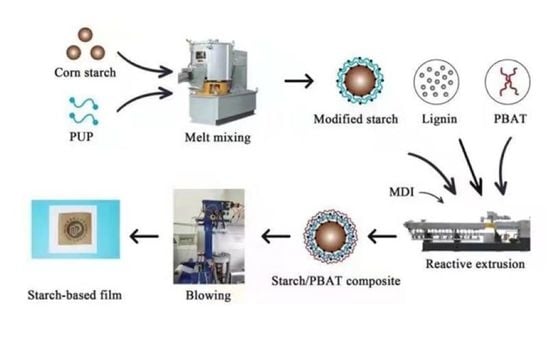Continuous Blown Film Preparation of High Starch Content Composite Films with High Ultraviolet Aging Resistance and Excellent Mechanical Properties
Abstract
:1. Introduction
2. Materials and Methods
2.1. Materials
2.2. Preparation of Modified Starch
2.3. Preparation of Anti-Ultraviolet Aging Starch-Based Film
2.4. Methods
2.4.1. Infrared Spectroscopy Analysis
2.4.2. Crystal Morphology Analysis
2.4.3. Contact Angle and Water Vapor Transmission Rate
2.4.4. Microscopic Morphology Observation
2.4.5. Mechanical Performance Characterization
2.4.6. Ultraviolet-Visible Light Absorption Performance Test
2.4.7. UV Aging Performance Test
2.4.8. Heat Sealing Performance Test
3. Results and Discussion
3.1. Infrared Results of Composite Materials with Lignin
3.2. Crystal Structure of Starch-Based Films
3.3. Hydrophilic and Hydrophobic Properties
3.4. Morphology Observation
3.5. Mechanical Properties
3.6. Ultraviolet-Visible Light Absorption Analysis
3.7. UV Aging Performance Analysis
3.8. Sealing Strength
4. Conclusions
Author Contributions
Funding
Data Availability Statement
Acknowledgments
Conflicts of Interest
References
- Othman, S.H.; Othman, N.; Shapi’I, R.A.; Ariffin, S.H.; Yunos, K. Corn starch/chitosan nanoparticles/thymol bio-nanocomposite films for potential food packaging applications. Polymers 2021, 13, 390. [Google Scholar] [CrossRef]
- Briassoulis, D.; Giannoulis, A. Evaluation of the functionality of bio-based plastic mulching films. Polym. Test. 2018, 67, 99–109. [Google Scholar] [CrossRef]
- Othman, S.H.; Kechik, N.R.A.; Shapi’i, R.A.; Talib, R.A.; Tawakkal, I.S.M.A. Water sorption and mechanical properties of starch/chitosan nanoparticle fifilms. J. Nanomater. 2019, 2019, 3843949. [Google Scholar] [CrossRef] [Green Version]
- Singh, P.; Sharma, V.P. Integrated plastic waste management: Environmental and improved health approaches. Procedia Environ. Sci. 2016, 35, 692–700. [Google Scholar] [CrossRef]
- Kumar, M.V.; Sheela, A.M. Effect of plastic film mulching on the distribution of plastic residues in agricultural fields. Chemosphere 2020, 273, 128590. [Google Scholar] [CrossRef]
- Isikgor, F.H.; Becer, C.R. Lignocellulosic biomass: A sustainable platform for the production of bio-based chemicals and polymers. Polym. Chem. 2015, 6, 4497–4559. [Google Scholar] [CrossRef] [Green Version]
- Ahorsu, R.; Medina, F.; Constantí, M. Significance and Challenges of Biomass as a Suitable Feedstock for Bioenergy and Biochemical Production: A Review. Energies 2018, 11, 3366. [Google Scholar] [CrossRef] [Green Version]
- Van Sebille, E.; Wilcox, C.; Lebreton, L.; Maximenko, N.; Hardesty, B.D.; Van Franeker, J.A.; Eriksen, M.; Siegel, D.; Galgani, F.; Law, K.L. A global inventory of small floating plastic debris. Environ. Res. Lett. 2015, 10, 124006. [Google Scholar] [CrossRef]
- Cole, M.; Lindeque, P.; Halsband, C.; Galloway, T.S. Microplastics as contaminants in the marine environment: A review. Mar. Pollut. Bull. 2011, 62, 2588–2597. [Google Scholar] [CrossRef]
- Hurley, R.; Woodward, J.; Rothwell, J.J. Microplastic contamination of river beds significantly reduced by catchment-wide flooding. Nat. Geosci. 2018, 11, 251–257. [Google Scholar] [CrossRef]
- Cheng, H.; Wang, L. Lignocelluloses Feedstock Biorefinery as Petrorefinery Substitutes. In Biomass Now—Sustainable Growth and Use; Intech.: Rigeta, Croatia, 2013; pp. 347–388. [Google Scholar]
- Klemm, D.; Kramer, F.; Moritz, S.; Lindström, T.; Ankerfors, M.; Gray, D.; Dorris, A. Nanocelluloses: A new family of nature-based materials. Angew. Chem. Int. Ed. 2011, 50, 5438–5466. [Google Scholar] [CrossRef]
- Park, J.-S.; Han, S.-Y.; Bandi, R.; Lee, E.-A.; Cindradewi, A.-W.; Kim, J.-K.; Kwon, G.-J.; Seo, Y.-H.; Youe, W.-J.; Gwon, J.; et al. Wet-Spun Composite Filaments from Lignocellulose Nanofibrils/Alginate and Their Physico-Mechanical Properties. Polymers 2021, 13, 2974. [Google Scholar] [CrossRef]
- Xing, Q.Q.; Buono, P.; Ruch, D.; Dubois, P.; Wu, L.B.; Wang, W.J. Biodegradable UV-Blocking Films through Core-Shell Lignin-Melanin Nanoparticles in Poly(butylene adipate-co-terephthalate). ACS Sustain. Chem. Eng. 2019, 7, 4147–4157. [Google Scholar] [CrossRef]
- Lora, J.H.; Glasser, W.G. Recent industrial applications of lignin: A sustainable alternative to nonrenewable materials. J. Polym. Environ. 2002, 10, 39–48. [Google Scholar] [CrossRef]
- Sadeghifar, H.; Venditti, R.; Jur, J.; Gorga, R.E.; Pawlak, J.J. Cellulose-Lignin Biodegradable and Flexible UV Protection Film. Acs Sustain. Chem. Eng. 2017, 5, 625–631. [Google Scholar] [CrossRef]
- Xing, Q.Q.; Ruch, D.; Dubois, P.; Wu, L.B.; Wang, W.J. Biodegradable and High-Performance Poly(butylene adipate-co-terephthalate)-Lignin UV-Blocking Films. ACS Sustain. Chem. Eng. 2017, 5, 10342–10351. [Google Scholar] [CrossRef]
- Zhang, C.H.; Chen, F.P.; Meng, W.; Li, C.Q.; Cui, R.; Xia, Z.; Liu, C.S. Polyurethane prepolymer-modified high-content starch-PBAT films. Carbohydr. Polym. 2021, 253, 117168. [Google Scholar] [CrossRef]
- Weng, F.; Liu, X.; Koranteng, E.; Ma, N.; Wu, Q. Structure and properties of a compatible wood-plastic composite prepared by using poly(butylene succinate)-based polyurethane prepolymer. Polym. Compos. 2019, 40, 4694–4703. [Google Scholar] [CrossRef]
- Dan, D.; Ying, T.A.; Zeng, W.; Li, J.; Hui, L.; Li, S. Preparation and characterization of maltodextrin-based polyurethane. Carbohydr. Polym. 2018, 194, 236–244. [Google Scholar]
- Zhai, X.; Wang, W.; Zhang, H.; Dai, Y.; Dong, H.; Hou, H. Effects of high starch content on the physicochemical properties of starch/pbat nanocomposite films prepared by extrusion blowing. Carbohydr. Polym. 2020, 239, 116231. [Google Scholar] [CrossRef]
- Wu, Q.X.; Zhang, P.P.; Zhang, Y.; Fan, B.B.; Zhu, M.; Wu, Z.S. Thermoplastic starch modified with hydrophobic polyurethane microparticles. Starch-Stärke 2011, 63, 373–380. [Google Scholar] [CrossRef]
- Meng, W.; Chen, F.P.; Zhang, C.H.; Cui, R.H.; Wang, P.L.; Liu, C.S. Polyurethane prepolymer modified cassava starch based poly(butylene adipate-co-terephthalate) composites with excellent compatibility and high toughness. Starch-Stärke 2019, 71, 9–10. [Google Scholar] [CrossRef]
- Pozo, C.; Rodriguez-Llamazares, S.; Bouza, R.; Barral, L.; Castano, J.; Muller, N.; Restrepo, I. Study of the structural order of native starch granules using combined FTIR and XRD analysis. J. Polym. Res. 2018, 25, 266. [Google Scholar] [CrossRef]
- Li, X.; Tan, D.; Xie, L.; Sun, H.; Sun, S.; Zhong, G.; Ren, P. Effect of surface property of halloysite on the crystallization behavior of PBAT. Appl. Clay Sci. 2018, 157, 218–226. [Google Scholar] [CrossRef]
- Singh, R.; Prakash, A.; Dhiman, S.K.; Balagurumurthy, B.; Arora, A.K.; Puri, S.K.; Bhaskar, T. Hydrothermal conversion of lignin to substituted phenols and aromatic ethers. Bioresour. Technol. 2014, 165, 319–322. [Google Scholar] [CrossRef]
- Yu, J.; Wang, J.F.; Wang, C.P.; Liu, Y.P.; Xu, Y.Z.; Tang, C.B.; Chu, F.X. UV-Absorbent Lignin-Based Multi-Arm Star Thermoplastic Elastomers. Macromol. Rapid Comm. 2015, 36, 398–404. [Google Scholar] [CrossRef]
- Mishra, S.B.; Mishra, A.K.; Kaushik, N.K.; Khan, M.A. Study of performance properties of lignin-based polyblends with polyvinyl chloride. J. Mater. Process. Technol. 2007, 183, 273–276. [Google Scholar] [CrossRef]
- Li, C.Q.; Chen, F.P.; Lin, B.W.; Zhang, C.H.; Liu, C.S. High content corn starch/Poly (butylene adipate-co-terephthalate) composites with high-performance by physical–chemical dual compatibilization. Eur. Polym. J. 2021, 159, 110737. [Google Scholar] [CrossRef]
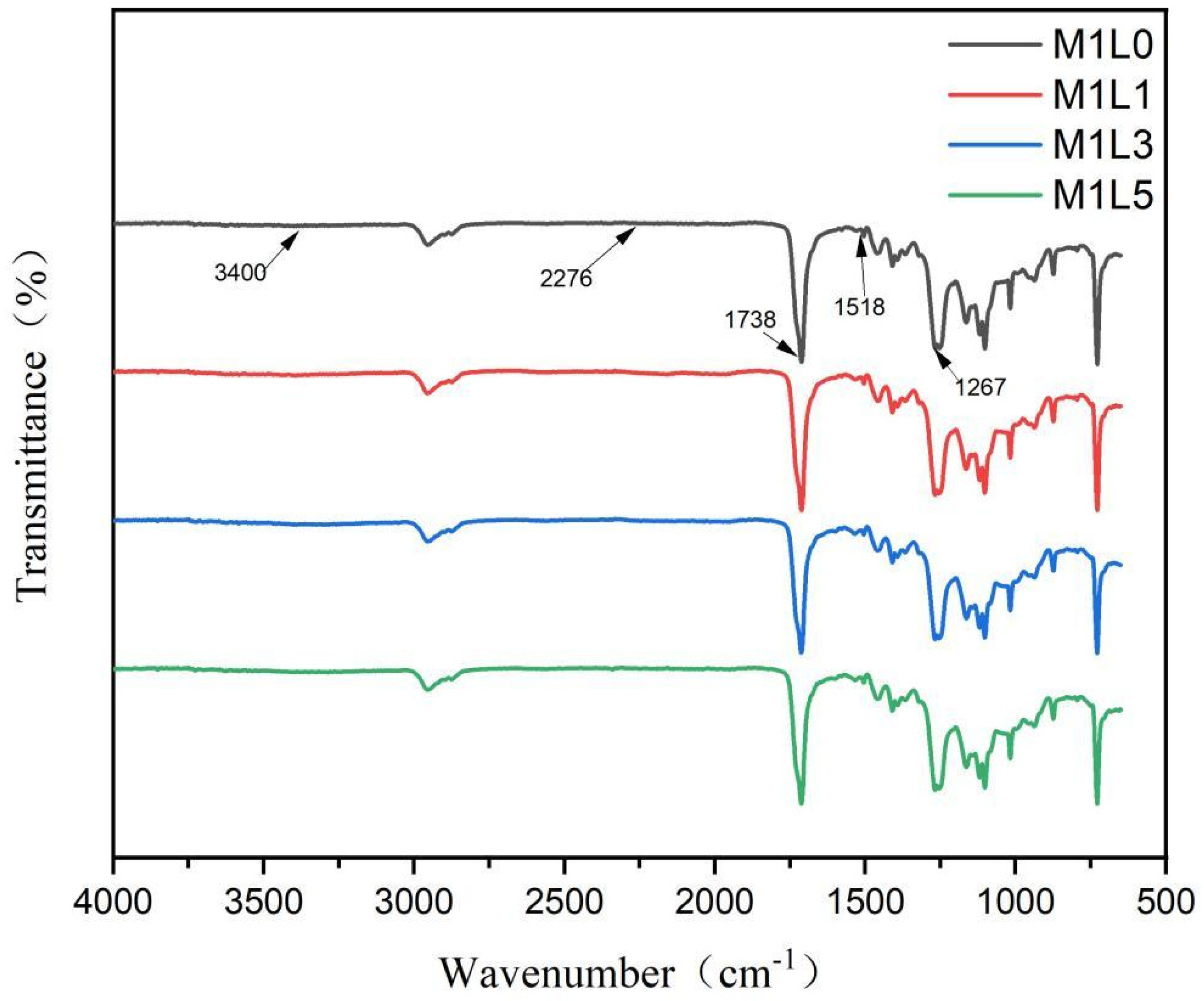
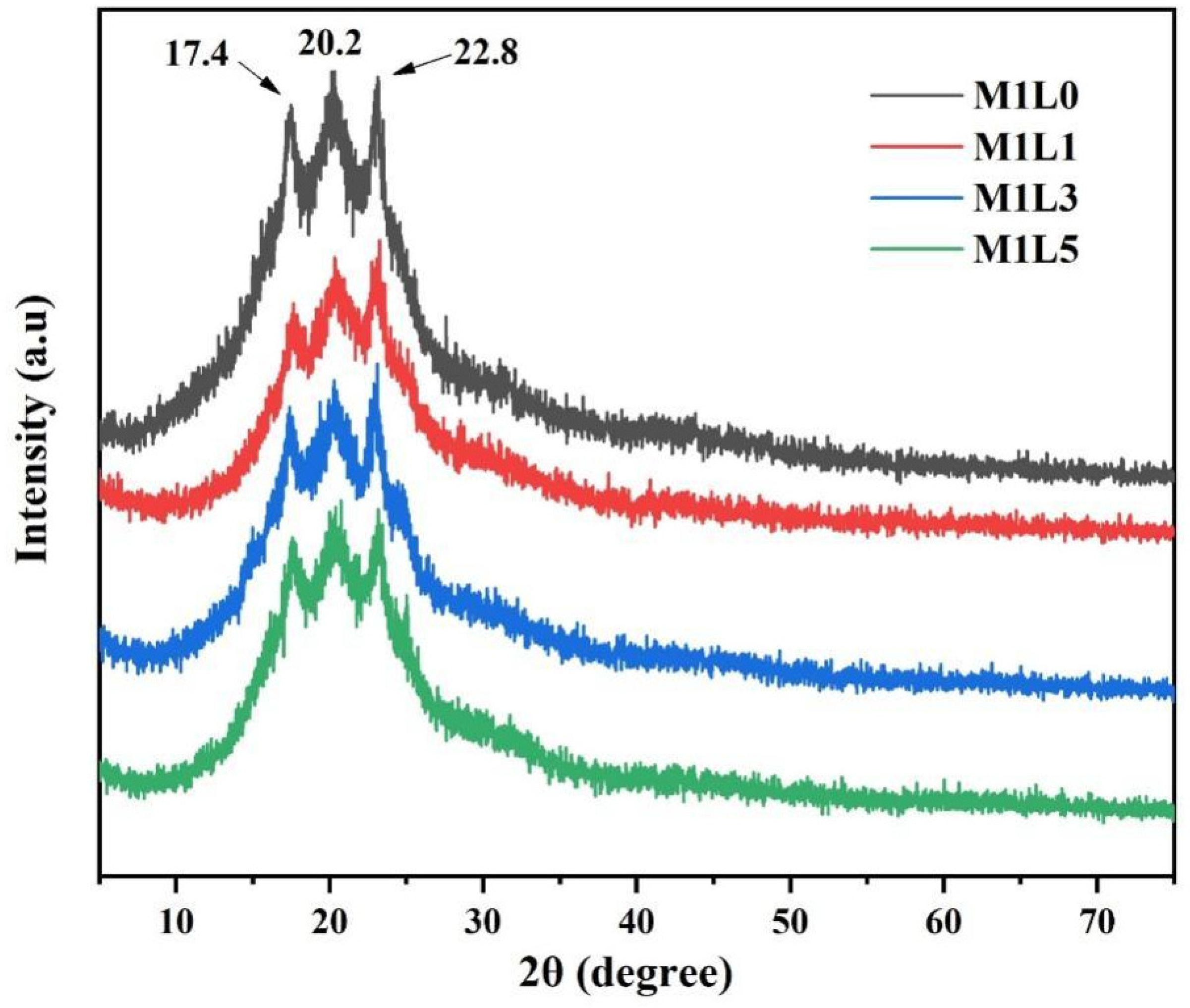
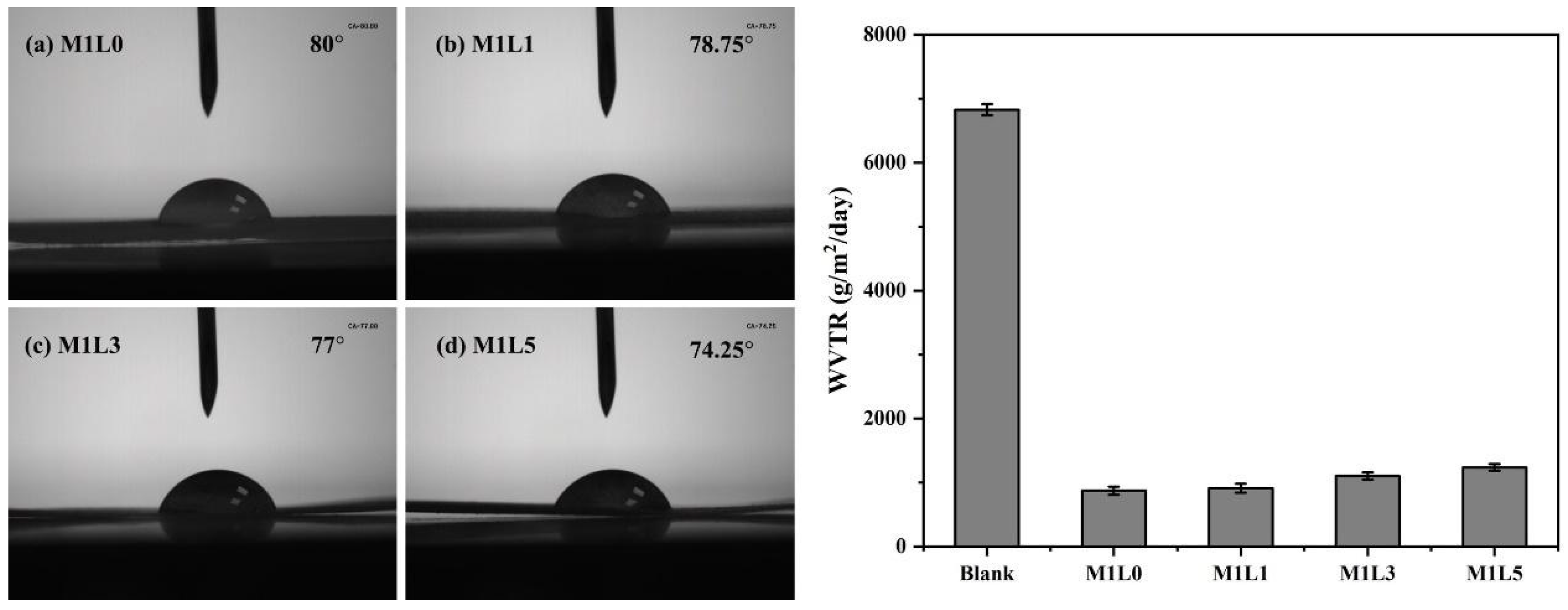
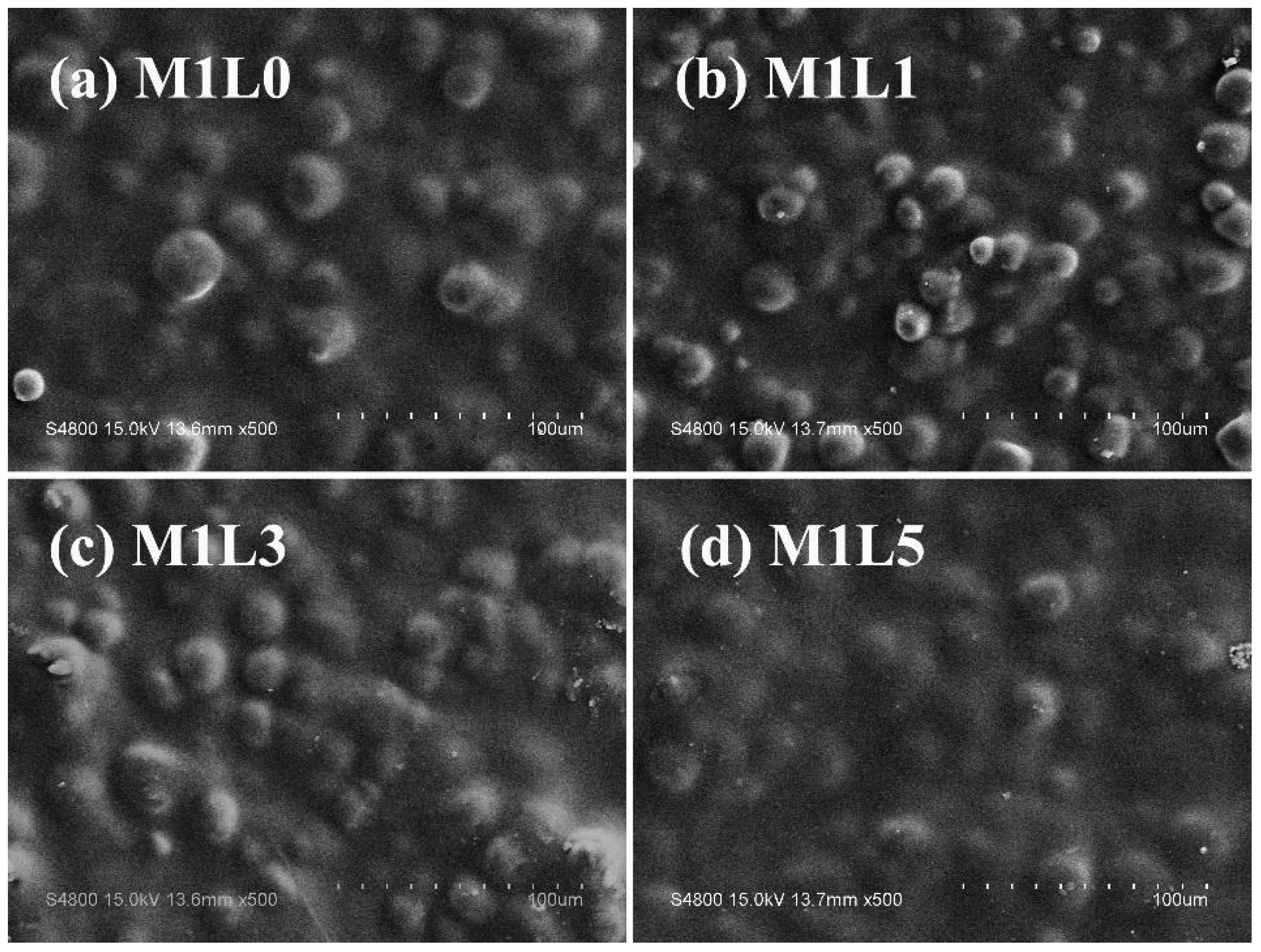
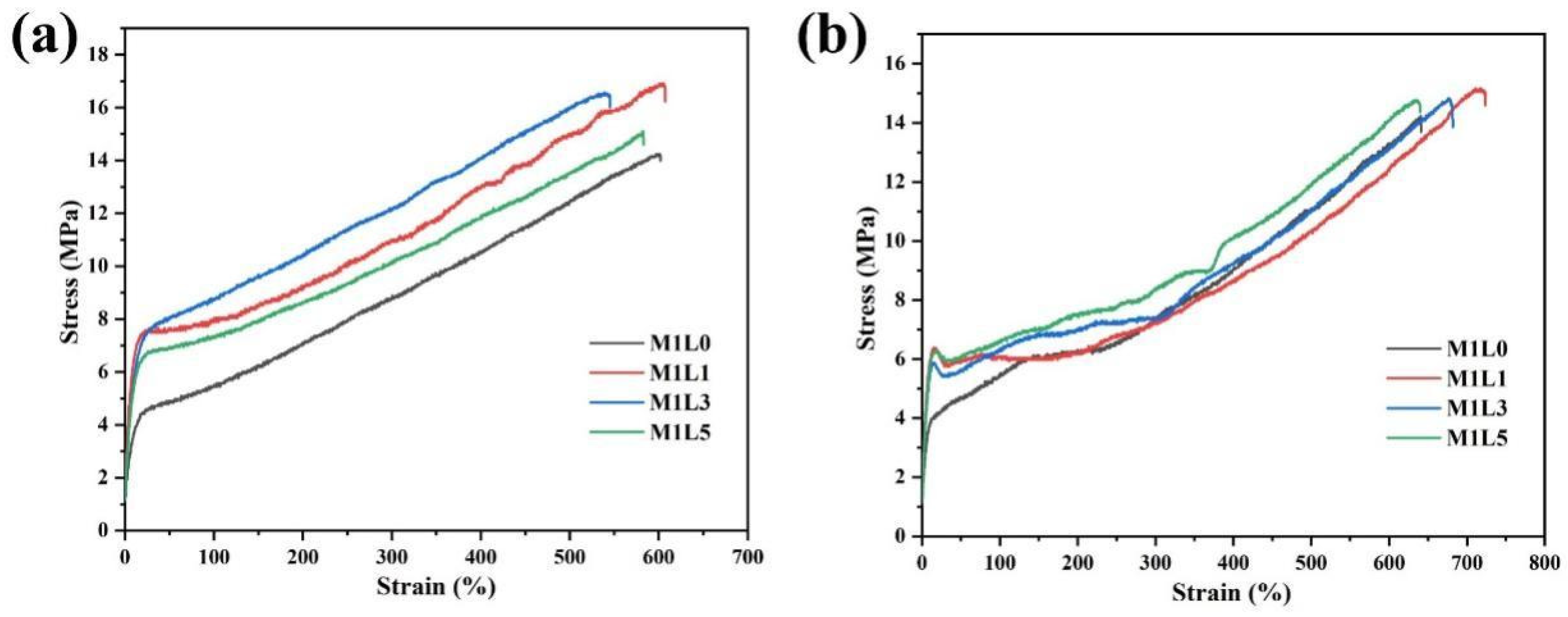
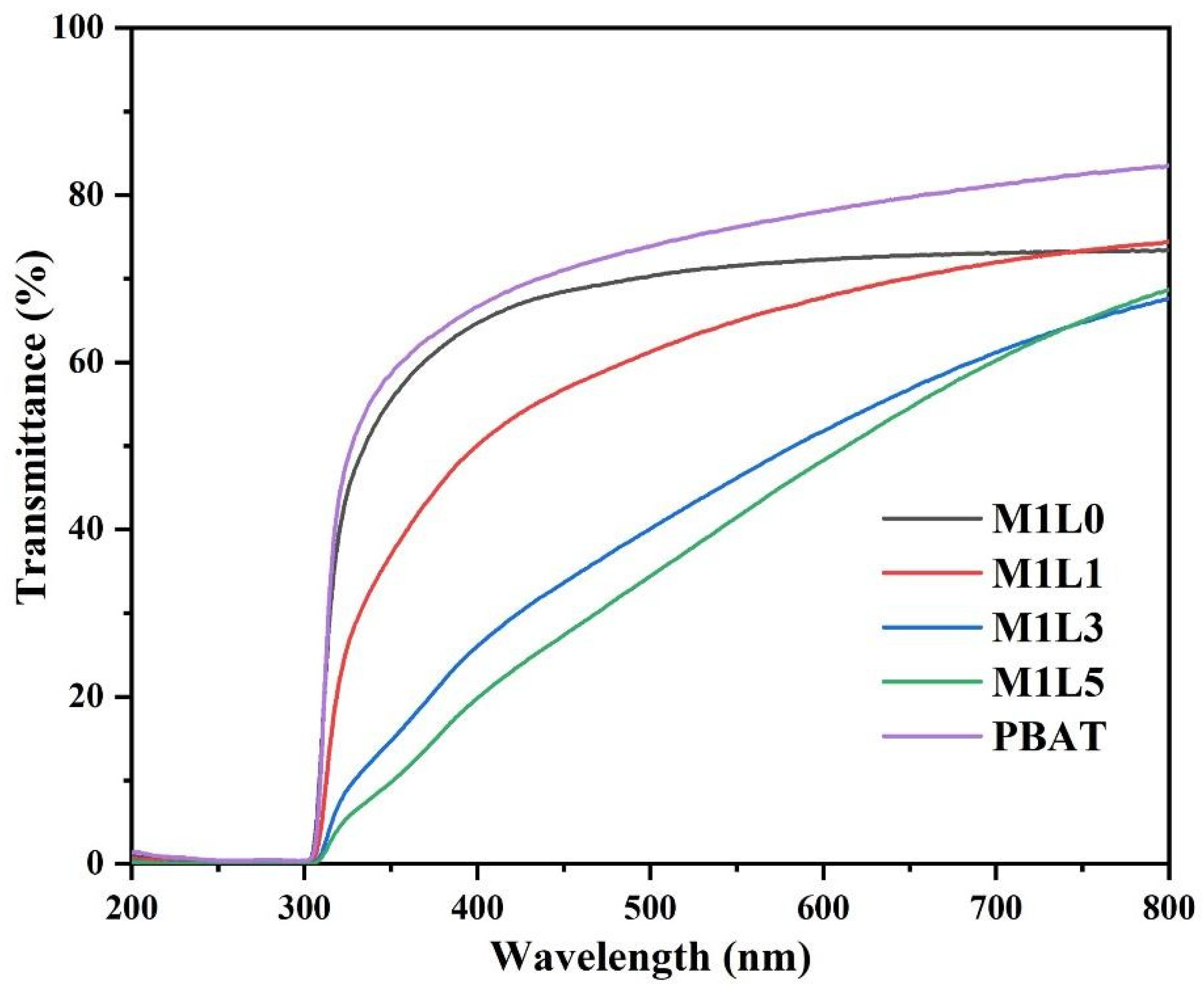

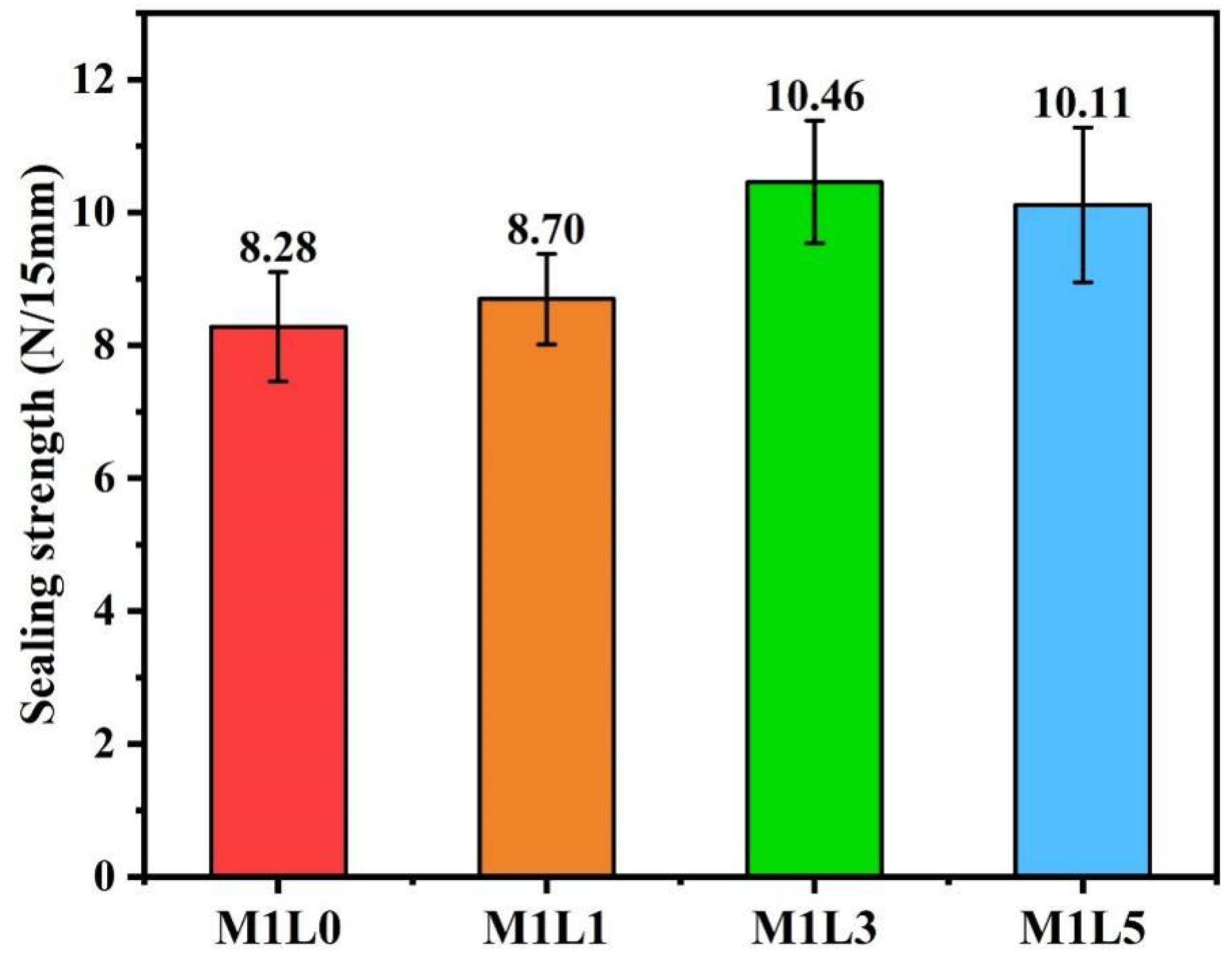
| Samples | Modified Starch (wt.%) | PBAT (wt.%) | MDI (phr) | Lignin (phr) |
|---|---|---|---|---|
| M1L0 | 50 | 50 | 1 | 0 |
| M1L1 | 50 | 50 | 1 | 1 |
| M1L3 | 50 | 50 | 1 | 3 |
| M1L5 | 50 | 50 | 1 | 5 |
| Samples | Contact Angle (°) | WVTR (g/m2/day) |
|---|---|---|
| Blank | – | 6828.95 ± 88.62 |
| M1L0 | 80.00 ± 0.50 | 865.57 ± 14.02 |
| M1L1 | 78.75 ± 0.25 | 907.04 ± 13.12 |
| M1L3 | 77.00 ± 0.50 | 1125.18 ± 12.74 |
| M1L5 | 74.25 ± 0.25 | 1185.00 ± 9.92 |
| Samples | Direction | Tensile Strength (MPa) | Elongation at Break (%) |
|---|---|---|---|
| M1L0 | Horizontal | 14.04 ± 1.29 | 619.03 ± 28.54 |
| Longitudinal | 14.23 ± 1.77 | 596.41 ± 22.68 | |
| M1L1 | Horizontal | 15.31 ± 0.98 | 715.88 ± 42.52 |
| Longitudinal | 15.87 ± 1.58 | 602.21 ± 39.17 | |
| M1L3 | Horizontal | 14.58 ± 1.53 | 658.96 ± 29.98 |
| Longitudinal | 15.11 ± 1.36 | 562.47 ± 33.86 | |
| M1L5 | Horizontal | 14.23 ± 0.98 | 671.36 ± 38.12 |
| Longitudinal | 15.03 ± 1.33 | 588.41 ± 34.72 |
| Samples | Tensile Strength (MPa) | Elongation at Break (%) | ||||
|---|---|---|---|---|---|---|
| Before | After | CRσ | Before | After | CRε | |
| M1L0-L | 14.23 ± 1.77 | 10.51 ± 1.52 | 76.25% | 596.41 ± 22.68 | 421.87 ± 21.76 | 70.73% |
| M1L0-H | 14.04 ± 1.29 | 9.96 ± 1.03 | 70.94% | 619.03 ± 28.54 | 425.51 ± 25.32 | 68.74% |
| M1L1-L | 15.87 ± 1.58 | 12.83 ± 0.89 | 80.84% | 602.21 ± 39.17 | 458.65 ± 31.25 | 76.16% |
| M1L1-H | 15.31 ± 0.98 | 11.63 ± 0.68 | 75.96% | 715.88 ± 42.52 | 521.59 ± 30.26 | 72.85% |
| M1L3-L | 15.11 ± 1.36 | 12.46 ± 1.31 | 82.46% | 562.47 ± 33.86 | 443.72 ± 26.37 | 78.89% |
| M1L3-H | 14.58 ± 1.53 | 11.37 ± 0.78 | 77.98% | 658.96 ± 29.98 | 495.22 ± 35.68 | 75.15% |
| M1L5-L | 15.03 ± 1.33 | 12.84 ± 1.16 | 85.43% | 588.41 ± 34.72 | 475.61 ± 36.41 | 80.82% |
| M1L5-H | 14.23 ± 0.98 | 11.52 ± 1.32 | 80.95% | 671.36 ± 38.12 | 517.94 ± 30.84 | 77.14% |
Publisher’s Note: MDPI stays neutral with regard to jurisdictional claims in published maps and institutional affiliations. |
© 2021 by the authors. Licensee MDPI, Basel, Switzerland. This article is an open access article distributed under the terms and conditions of the Creative Commons Attribution (CC BY) license (https://creativecommons.org/licenses/by/4.0/).
Share and Cite
Lin, B.; Li, C.; Chen, F.; Liu, C. Continuous Blown Film Preparation of High Starch Content Composite Films with High Ultraviolet Aging Resistance and Excellent Mechanical Properties. Polymers 2021, 13, 3813. https://doi.org/10.3390/polym13213813
Lin B, Li C, Chen F, Liu C. Continuous Blown Film Preparation of High Starch Content Composite Films with High Ultraviolet Aging Resistance and Excellent Mechanical Properties. Polymers. 2021; 13(21):3813. https://doi.org/10.3390/polym13213813
Chicago/Turabian StyleLin, Bowen, Chengqiang Li, Fangping Chen, and Changsheng Liu. 2021. "Continuous Blown Film Preparation of High Starch Content Composite Films with High Ultraviolet Aging Resistance and Excellent Mechanical Properties" Polymers 13, no. 21: 3813. https://doi.org/10.3390/polym13213813
APA StyleLin, B., Li, C., Chen, F., & Liu, C. (2021). Continuous Blown Film Preparation of High Starch Content Composite Films with High Ultraviolet Aging Resistance and Excellent Mechanical Properties. Polymers, 13(21), 3813. https://doi.org/10.3390/polym13213813




